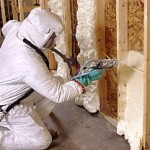Hansen Pole Buildings Designer Rachel asked me about this today:
“I have more and more builders say they put Tyvek® on the walls and roof and then spray foam. This is so they can replace the siding/roofing in the future. Do you find any downfalls with this? I thought this was a pretty good idea.”
Having just written an article about spray foam insulation (https://www.hansenpolebuildings.com/2016/07/advantages-spray-foam-over-batt-insulation/), this is a well timed question.
Tyvek and all house wraps are NOT (I repeat NOT) vapor barriers. They are weather barriers: https://www.hansenpolebuildings.com/2016/01/determining-the-most-effective-building-weather-resistant-barrier-part-1/.
 In doing my research on the whys and why-nots I found apparently there are some spray foam insulation contractors who will not spray foam against house wraps, apparently from not being able to guarantee their product would properly adhere to the house wrap.
In doing my research on the whys and why-nots I found apparently there are some spray foam insulation contractors who will not spray foam against house wraps, apparently from not being able to guarantee their product would properly adhere to the house wrap.
In one particular case – the spray foam insulation contractor tried to persuade the client to use BIBS® insulation (read about BIBS® here: https://www.hansenpolebuildings.com/2011/11/bibs/) due to the potential adhesion issues.
There apparently is an adhesive additive for spray foam, which will assist in the foam being able to stick to house wraps or other slick surfaces.
As closed cell spray foam is a vapor barrier, and is resistant to moisture passing through it in either direction, adding a weather barrier to the outside becomes redundant.
As a good, high quality steel roofing and siding should last the life of the building – installing any product between it and the siding, under the premise of making future replacement easier, it sounds much more like someone trying to make a feature into a benefit, than it does something which will add value to the client as a benefit!







Never spray foam to visqueen poly vapor barrier. 1st Poly is a releaseable substrate for spray foam. 2nd poly expands when heated, spray foam comes out of the gun at 120 and can have a exothermic reaction up to 180. This will cause the poly to stretch bubble and sag.
I’ve been in the foam business 5 years and I have thousands of industry friends and I have never heard of a adhesive additive for spray foam. Anything added to the drums would void the manufacturers warenty. Not smart. Foam stick by itself when properly applied. If it does not stick it when sprayed there is something wrong. Or improper substrate, moisture present, dust and dirt present, etc.
Please take this article down! It is full of bad information!
If the article is “full” of bad information, please point out the specific points and factual evidence (not just your opinion) and I will happily edit the article. There does seem to be some prior discussions on this subject at: https://sprayfoam.com/forum/topic/house-wrap-or-not/244, as well as at: https://www.garagejournal.com/forum/showthread.php?t=73431, either of which may be of benefit to the readers. You might want to take note of my referring readers to discuss options with installers.
Matt, I will invite you, or any industry expert to be a guest blogger – your article should be 300-900 words and support any positions with evidence beyond just your own opinion. The article cannot be a “buy from me” article and should be entertaining and informative.
I am wondering if you have any info increased structural
Strength of Spray foam. I have a contractor building a pole barn for a garage. It is my opinion that if you would spray the foam directly on the metal it would increase the structural strength of the building. It would glue it all together. If you spray it on house wrap I do not see where it would increase the the structure very much.
While I agree spray foam direct to inside of steel stiffens building up, I have not seen any studies to quantitatively back up what I have seen in real life.
This statement from the article ignores damage from other than normal weather: “As a good, high quality steel roofing and siding should last the life of the building”. This is correct if your kids don’t drive into it, make a poor decision with the weed whacker, smack into it with the lawn mower, etc. Also, those beloved hail storms dropping ice baseballs onto the roof. None of these should be expected to be covered by warranty.
Regarding Matt’s comment back in 2017, the first 2nd-4th sentences seem to be exactly the “specific points” you demand in your response to him.
Thanks to a lack of follow up in the last 7 years, I have read the article and am no better off than I was before.
Not sure what damage from other than normal weather has to do with the article Loren, but thank you for giving your opinion.
Other than normal weather damage would require a replacement of the sheet metal panels on a pole barn building and if the back of that sheet is spray foamed to the building it’s going to make replacement more challenging. Especially if the inside of the pole barn has finished interior walls and the spray foam is no longer accessible to respray. Respring spray foam is almost guaranteed for every time you have to replace a sheet metal panel. As far as roofing goes that means you may have to respray your whole roof after 50 years goes by and you need to replace the sheet metal. For everyone saying that you are just going to replace the whole building after 50 years that’s extremely wasteful way of thinking. A properly built pole barn with good soil drainage could stand 200,300 years if the roof is kept tight.
Steel panels will pull right off from closed cell spray foam, or screws can be removed from panels – place replacements directly over them and screw through both.